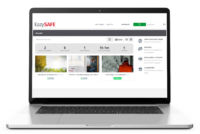Top 5 Health & Safety Trends for 2025
Introduction: Embracing the Future of Workplace Safety
As workplaces evolve, so do the challenges associated with maintaining a safe and healthy environment. Staying abreast of emerging trends is crucial for organizations aiming to protect their workforce and enhance productivity. We will look at the top five Workplace Safety Trends 2025 anticipated to shape workplaces in 2025.
Overview: The Importance of Adapting to New Safety Paradigms
The landscape of workplace health and safety is continually shifting, influenced by technological advancements, societal changes, and environmental factors. Organizations that proactively adapt to these trends not only ensure compliance with regulations but also foster a culture of well-being and resilience among employees. Digital safety solutions, such as those offered by EazySafe, play a key role in providing businesses with innovative tools for workplace safety training and compliance.
Key Workplace Safety Trends 2025

Advanced Training Methods:
With technological evolution, modern safety solutions have emerged. Online training has gained popularity for its convenience and accessibility. Courses like manual handling are now available online, allowing completion at any time and place. However, as reliance on online training grows, so do expectations for engaging, easy-to-follow, and high-quality courses. Well-crafted courses receive positive feedback and attract more participants. Platforms like EazySafe offer customizable safety training solutions tailored to different industries.

Integration of Wearable Technology:
Wearable devices, such as smartwatches, have become prevalent in monitoring health and well-being. These devices can detect high noise levels and prompt users to reduce noise or wear ear protection. For office workers, they can remind users to stand and walk periodically, promoting physical activity and reducing health risks associated with prolonged sitting.

Data-Driven Decision Making:
Advancements in technology have enabled the use of data to analyze workplace accidents. Safety managers and consultants can assess when, where, and why accidents occur, allowing for prediction and prevention. For instance, if multiple accidents are reported in a specific area of a construction site, managers can investigate and address root causes, such as the need for special training, safety gear, or improved lighting. Digital safety platforms like EazySafe help organizations track and manage safety compliance efficiently.

Focus on Mental Health:
Recent years have seen increased openness about mental health issues. While physical health has traditionally been prioritized, companies now recognize the importance of mental well-being. Employers are providing on-site mental health resources, implementing flexible work schedules, and sponsoring therapy sessions to alleviate work-related stress and support employees’ mental health.

Climate Change and Workplace Adaptation:
Workplace Safety Trends 2025 highlight how climate change increasingly impacts workplaces, with extreme weather events becoming more frequent. In January 2025, Ireland experienced its strongest storm in over 80 years, causing power outages in businesses, farms, and homes. This event prompted businesses to develop emergency plans and adapt to such situations to ensure continuity and safety. Implementing emergency preparedness training can help organizations stay prepared for unexpected disruptions, a key trend in Workplace Safety Trends 2025.
Takeaways: Implementing Future-Ready Safety Measures
1. Invest in Modern Training:
Utilize engaging online courses to equip employees with essential safety skills.
2. Leverage Wearable Technology:
Incorporate devices that monitor environmental conditions and promote healthy behaviors.
3. Prioritize Mental Health:
Establish resources and policies that support employees’ psychological well-being.
4. Utilize Data Analytics:
Implement systems to collect and analyze safety data for informed decision-making.
5. Prepare for Climate Challenges:
Develop and regularly update emergency response plans to address extreme weather events.
Conclusion: Proactive Steps Toward a Safer Workplace
Adapting to emerging workplace safety trends in 2025 is essential for organizations committed to safeguarding their employees. By embracing advanced training methods, integrating wearable technology, focusing on mental health, utilizing data-driven strategies, and preparing for climate-related challenges, businesses can create resilient and secure work environments. See also new government strategy in relation to health and safety from the HSA.
We invite you to share your thoughts and experiences regarding these evolving health and safety trends. Join the conversation below to contribute to a safer future for all.

TAILORED TRAINING
Discover our safety training courses and ehs onboardings, which can be customised and offered in several languages.

SAFETY MANAGEMENT
Ensure the distribution of your safety policy by training your permanent, temporary or seasonal staff.

GLOBAL MONITORING
Simplify the management of your safety policy thanks to the numerous dashboards and training reports.
